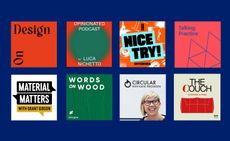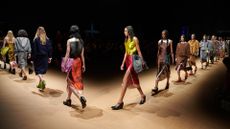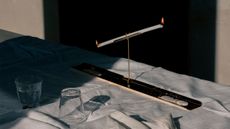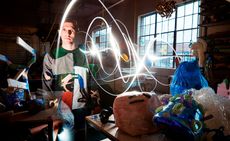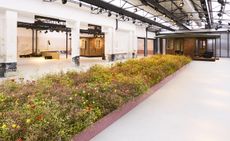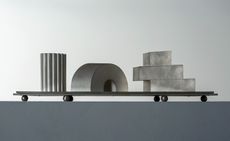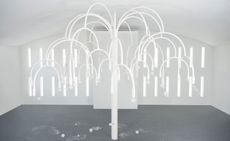Hella Jongerius weaves the cosmos at Berlin’s Gropius Bau
On the occasion of her ‘Woven Cosmos’ exhibition at Berlin's Gropius Bau in Spring 2021, we talked to Hella Jongerius about textiles and weaving, sustainability in design and the effect of the pandemic on daily life
- (opens in new tab)
- (opens in new tab)
- (opens in new tab)
- Sign up to our newsletter Newsletter
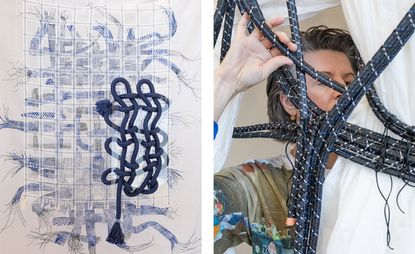
Sustainable innovation, craft, responsible production, and how we relate to objects and nature are recurring themes in the work of Dutch designer Hella Jongerius. A new series of textile (opens in new tab) experiments and an exhibition at Berlin’s Gropius Bau, ‘Hella Jongerius: Woven Cosmos’, presents a panoramic take on her thinking.
‘I have always worked on the relationship between objects and human beings; objects are silent partners, there is a lot of healing in them,’ says Jongerius, whose work over the past three decades has touched upon industrial design, furniture (opens in new tab), craft, material explorations and chromatic research.

Jongerius photographed at the Gropius Bau during her exhibition's development. In the background is ‘Forest’, a piece from the ‘Woven Systems’ series
Her ongoing work with colour has led her to collaborate with textile manufacturers Maharam and Kvadrat; to leave her mark on classic Vitra furniture by Jean Prouvé, and Charles and Ray Eames; and to design the North Delegates’ Lounge for the United Nations’ New York headquarters. These experiences, alongside more in-depth research, culminated in exhibitions such as ‘Colour Machine’ at Milan Design Week in 2016 and ‘Breathing Colour’ at London’s Design Museum in 2017 (opens in new tab).
‘Hella Jongerius: Woven Cosmos’ exhibition at Gropius Bau

Jongerius holds a silk-screen print sketch, part of her Woven Systems series
The newest chapter of her work focuses on weaving, a medium that allows Jongerius to explore some of those recurring themes, particularly sustainability, social responsibility, spirituality and ‘the healing function of objects’. The idea for the Gropius Bau exhibition developed after Jongerius spent time working on a digital loom, leaving her keen to investigate more experimental and performative weaving techniques. ‘Weaving is such a huge topic,’ she notes. ‘And I wanted to do it in a bigger realm, so I called the show ‘Woven Cosmos’: I wanted to work with metaphors, diving deeper into the future of weaving.’
Presented as a work in progress, ‘Woven Cosmos’ includes two new installations and more than 50 new objects created by Jongerius and her team between her Berlin studio and the neo-Renaissance halls of the museum, with some pieces developed live on site during the exhibition. Jongerius brought a multilayered and personal approach to the project, including a spiritual séance led by a local shaman in the Gropius Bau’s atrium before production started, which highlighted the vitality of the building.
'We are all yarns in the bigger cloth, all interwoven’
Hella Jongerius
The end result includes three-dimensional textile sculptures created with yarns spun from recycled materials (opens in new tab) – old stock from the textile industry, virgin cotton, wool and paper yarns used for weaving – alongside objects in wood, glass and ceramics (opens in new tab). Jongerius looked through the museum’s archives for materials to repurpose, and found four shades of sand from a recent exhibition by artist Lee Mingwei, three of which have now been used to create glass pieces for ‘Woven Cosmos’ (a process carried out in Sweden and overseen by Jongerius over Zoom).

Studies for the ’Space Amulets’ series, featuring various materials and weaving techniques
The exhibition has three live elements, performed by the designer and her team, Jongeriuslab, with the public invited to join in. The Cosmic Loom installation features bundles of recycled textile waste, available to the team and visitors to use to spin a yarn to add to the loom. Another project, titled Dancing a Yarn, invites the public to be part of a choreographed workflow. Twisting and twining dancers perform alongside a machine, replicating its movements, to create two ropes. The resulting ropes are then be knotted together to form a ladder that ‘grows’ out of the building’s window and into the public space surrounding the museum.
RELATED STOR

Hella Jongerius creates limited-edition cover for Wallpaper’s May 2021 issue (opens in new tab)
Finally, Space Loom #2 (a large-scale, three-dimensional loom Jongerius previewed in a 2019 installation for Lafayette Anticipations in Paris), built by the designer and her collaborators out of four looms, is activated during the show to produce new 3D-woven objects named Matrix Modules.
The outcomes are unpredictable, but, as the designer points out, ‘it’s not about the result, it’s about the process’. She continues: ‘For me, it’s important that we research, and that what we do is restricted between boundaries, that we have questions. But we are doing the creative work; we are not just producing something that’s ready in our minds. That’s also how it works in design and with other creative processes.’

‘Web’ (shown unfinished), a work from the ‘Woven Systems’ series in cotton, silk screen print, various materials
Building a new body of work on site at Gropius Bau has been a helpful exercise for the team. ‘In the studio, everything looks big, and then we come into the museum and it shrinks,’ says Jongerius. ‘So it is really great that we can see the work at the right scale, under the right lights. I am not there every day, so my team has time to concentrate on a piece of work without being watched the whole time.’ She characterises the more intimate studio work as the ‘embryo’ stage of her projects, and finds the duality between the two spaces and dimensions refreshing.
Jongerius’ move from industrial design to a more experimental craft-based dimension has felt like a natural progression of her practice. From where she is now, she is able to communicate to a more open, critical audience that wants to explore beyond what’s currently possible.

‘Evening Light’, a work from the ‘Woven Windows’ series, also featuring on Wallpaper's limited edition May issue cover (opens in new tab). Woven on the digital Jacquard loom in the Jongeriuslab studio, various yarns
‘Craft is now more relevant than ever; these ancient techniques not only have cultural and historical value but also offer real solutions,’ she says. ‘A material never travels alone, it has a huge social and geopolitical agenda. To work towards a carbon-neutral footprint, we have to redesign all of our materials, and that has a lot to do with craft. There is a huge revolution in my profession.’
It’s impossible to create work in 2021 without feeling the impact of the ongoing global pandemic (opens in new tab), and for Jongerius, this has meant observing the world both digitally and physically. Its restrictions and new rules, she says, ‘will have an echo in our objects and materials’. This is also where weaving comes into play: ‘It’s almost a cliché, but we are all yarns in the bigger cloth. We are all interwoven, it’s about connection. And that’s why weaving is a very strong metaphor for where we are right now.’

A three-dimensional woven brick on the ’Space Loom #2’, part of the ‘Pliable Architecture’ series

The digital Jacquard Loom photographed in the Jongeriuslab studio

‘Frozen Rain Panorama’, a work from the ‘Woven Windows’ series, woven on the digital Jacquard loom in the Jongeriuslab studio

Cardboard models for the ’Space Amulets’ series

The piece ‘Cosmos’ from the series ‘Woven Systems’ at the temporary work space of Jongeriuslab at Gropius Bau

Samples for the work series ’Woven Systems’

A paper model of the Gropius Bau exhibition space and exhibition installation
INFORMATION
‘Hella Jongerius: Woven Cosmos’, until 15 August 2021
gropiusbau.de (opens in new tab)
jongeriuslab.com (opens in new tab)
ADDRESS
Gropius Bau
Niederkirchnerstrasse 7
Berlin
VIEW GOOGLE MAPS (opens in new tab)
Rosa Bertoli was born in Udine, Italy, and now lives in London. Since 2014, she has been the Design Editor of Wallpaper*, where she oversees design content for the print and online editions, as well as special editorial projects. Through her role at Wallpaper*, she has written extensively about all areas of design. Rosa has been speaker and moderator for various design talks and conferences including London Craft Week, Maison & Objet, The Italian Cultural Institute (London), Clippings, Zaha Hadid Design, Kartell and Frieze Art Fair. Rosa has been on judging panels for the Chart Architecture Award, the Dutch Design Awards and the DesignGuild Marks. She has written for numerous English and Italian language publications, and worked as a content and communication consultant for fashion and design brands.
-
 Design podcasts to discover: creative giants share smalltalk and big ideas
Design podcasts to discover: creative giants share smalltalk and big ideasListen to the best design podcasts by creators, curators and journalists shining a spotlight on different areas of the design practice
By Rosa Bertoli • Published
-
 2022 fashion highlights, as picked by the Wallpaper* team
2022 fashion highlights, as picked by the Wallpaper* teamThe Wallpaper* fashion and beauty team reflect on their personal 2022 fashion highlights – from Gaetano Pesce at Bottega Veneta and Wales Bonner in Florence to intrigue and seduction at Prada
By Jack Moss • Published
-
 Marre Moerel’s swinging flame candle uses artful balance
Marre Moerel’s swinging flame candle uses artful balanceVita Balanza by Marre Moerel and Santa & Cole has turned candles into a balancing act
By Martha Elliott • Published
-
 Maria Porro: ‘We are pouring our hearts into Supersalone’
Maria Porro: ‘We are pouring our hearts into Supersalone’Newly appointed Salone del Mobile president Maria Porro is the first woman in the role. She talks to Wallpaper* Milan editor Maria Cristina Didero, a Supersalone colleague, about her plans to focus the fair on design, sustainability and creative encounters
By Maria Cristina Didero • Last updated
-
 Hella Jongerius creates limited-edition cover for Wallpaper’s May 2021 issue
Hella Jongerius creates limited-edition cover for Wallpaper’s May 2021 issueEach month Wallpaper* offers a leading creative figure carte blanche to design a limited-edition cover. For our May 2021 Design Previews issue, Dutch designer and artist Hella Jongerius expanded on her Woven Windows series, a textile piece part of her new exhibition at Berlin’s Gropius Bau
By Rosa Bertoli • Last updated
-
 Misha Kahn prepares to unveil his latest shape-shifting works in New York
Misha Kahn prepares to unveil his latest shape-shifting works in New YorkAhead of his exhibition at Friedman Benda, Wallpaper* pays a visit to designer Misha Kahn to discuss digital and analogue proccesses, low-brow pop-culture, and being an anomaly in contemporary design
By Marina Cashdan • Last updated
-
 Making of: Lara Bohinc weaves her passions into Kasthall rug collection
Making of: Lara Bohinc weaves her passions into Kasthall rug collectionBy Alice Morby • Last updated
-
 Raf Simons creates dystopian neighbourhood with Kvadrat in Milan
Raf Simons creates dystopian neighbourhood with Kvadrat in MilanBy Laura May Todd • Last updated
-
 Craft masters convene at Salone del Mobile for the third edition of Doppia Firma
Craft masters convene at Salone del Mobile for the third edition of Doppia FirmaBy Becky Sunshine • Last updated
-
 International Women’s Day: leading female designers in their own words
International Women’s Day: leading female designers in their own wordsBy Sujata Burman • Last updated
-
 COS and Studio Swine branch out in Miami with scented bubble installation
COS and Studio Swine branch out in Miami with scented bubble installationBy Ali Morris • Last updated
